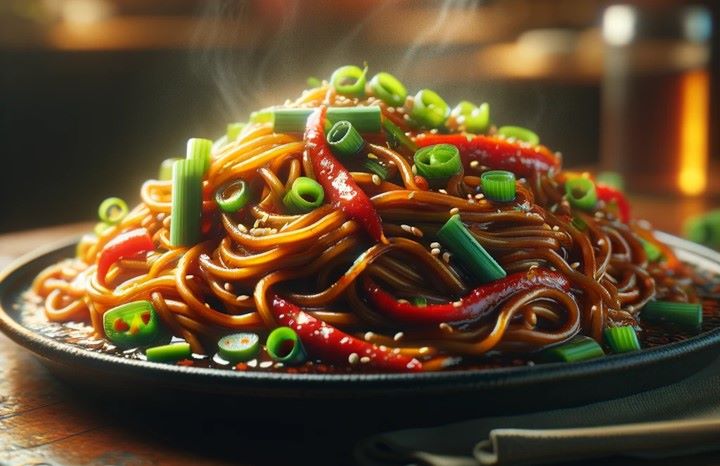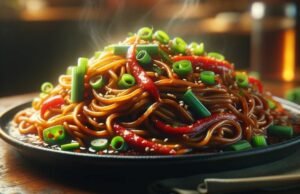Schezwan Noodles Recipe
The first time I made Schezwan noodles recipe at home, the tantalizing aroma had my entire home smelling like a top-notch Asian bistro. Ah! The gentle hiss of the stir-fry, the vibrant colors of the veggies, and those perfectly al dente noodles coated in that spicy-tangy sauce! It was like weaving magic in my kitchen. Each bite was a dance of fiery flavors and crunchy textures. It’s fascinating how certain dishes evoke feelings, and with these noodles, it felt like a burst of celebration in every mouthful.
What are Schezwan Noodles
Schezwan noodles primarily use long noodles, stir-fried with a medley of vegetables and occasionally proteins, bathed generously in the spicy Schezwan sauce. The end product is a delightful plate where each strand of noodle is coated evenly with the robust sauce, ensuring an explosion of flavors in your mouth. It is often hailed as a crown jewel in the realm of Indo-Chinese cuisine, are a testament to how two diverse culinary cultures can merge to produce something phenomenal. These noodles are not just about the heat; they encapsulate a beautiful harmony of flavors – spicy, tangy, and slightly sweet.
From the humble kitchen of a housewife to a dish that is blogged, reviewed, and loved universally, the Schezwan noodles have come a long way. It’s an embodiment of love, passion, and the wonders that a culinary blend of two cultures can create.
Variations to Schezwan Noodles Recipe
- Veggie Overload: Incorporate an array of vegetables like mushrooms, baby corn, and snow peas to make it more wholesome.
- Protein Punch: For meat lovers, adding pre-cooked chicken, shrimp, or even tofu can elevate the dish.
- Noodle Types: Switch between Hakka, Udon, or even whole-wheat noodles for a change in texture and taste.
- Heat Levels: Adjust the spice by using different variants of chilies or even opting for a milder Schezwan sauce.
Nutrition – Schezwan Noodles Recipe
Schezwan noodles are not just a treat for your taste buds but also come packed with nutritional benefits. Vegetables used in the stir-fry are powerhouses of essential vitamins and minerals. The carrots are rich in Vitamin A, while bell peppers provide Vitamin C. Using whole wheat or grain-based noodles can enhance the fiber content, aiding digestion. When prepared using lean proteins like chicken or tofu, it provides the body with essential amino acids. Moreover, ginger and garlic, integral to the recipe, have anti-inflammatory properties.
With the right balance and choice of ingredients, this dish can be both tasty and healthy!
Step by Step Schezwan Noodles Recipe

Schezwan Noodle Recipe
Ingredients
- 250 grams noodles
- 100 grams Carrot julienned
- 100 grams capsicum / bell peppers capsicum, thinly sliced
- 100 grams Cabbage shredded
- 50 grams spring onion finely chopped
- 50 grams spring onion finely chopped
- 4 tablespoons Schezwan sauce
- 2 tablespoons Soy sauce
- 2 tablespoons Oil
- 1 tablespoon Ginger finely chopped
- 1 tablespoon Garlic finely chopped
- 1 teaspoon Vinegar
- 1 teaspoon red sauce / red chilli sauce optional for extra heat
- Salt
Instructions
Preparation
- Start by boiling water in a large pan. Once boiling, add the noodles along with a pinch of salt. Cook until they're about 90% done - they should retain a slight bite.
- Drain the noodles and rinse them under cold water to halt the cooking process. This will keep them non-sticky. Set aside.
- Chop all your veggies finely, ensuring they're thinly sliced or julienned for quick cooking.
Cooking
- Heat oil in a wok or large pan. Once it's hot, add the finely chopped ginger and garlic. Sauté until they emit a pleasant aroma but ensure they don't brown.
- Add the spring onion whites and sauté for another 2 minutes.
- Introduce the julienned carrots, sliced bell peppers, and shredded cabbage to the wok. Stir fry on high heat for 2-3 minutes until the veggies soften slightly yet retain their crunch.
- Pour in the Schezwan sauce, soy sauce, vinegar, and red chili sauce. Mix everything well.
- Finally, toss in the noodles, ensuring they're well coated with the sauces and veggies. Stir-fry for another 2 minutes.
- Check seasoning, and if required, add salt. Remember, soy sauce and Schezwan sauce already have salt in them.
- Garnish with spring onion greens.

Equipment Used for This Recipe
Notes & Tips
- For the best flavor, always use a high-quality Schezwan sauce.
- You can increase or decrease the heat by adjusting the amount of Schezwan sauce or red chili sauce.
- If you're using non-vegetarian ingredients like chicken or shrimp, ensure they're cooked beforehand and then tossed in.
- The key to a great stir-fry is high heat and quick cooking. Ensure you've prepped everything before you start cooking.
Nutrition Information (Note: Approximate)
FAQs – Schezwan Noodles Recipe
What is the origin of Schezwan Noodles?
Schezwan Noodles hail from the Indo-Chinese cuisine lineage, a delightful fusion of Indian and Chinese culinary techniques. While the authentic Sichuan cuisine from China is known for its bold flavors, this noodle variant has been adapted to suit the Indian palate, making it a spicy, tangy, and slightly sweet delicacy loved by many.
How spicy are these noodles?
The spice level in Schezwan Noodles primarily depends on the Schezwan sauce used. Traditionally, it’s meant to be fiery. However, you can adjust the spice level by using milder chilies or reducing the quantity of sauce.
Can I use other types of noodles for this recipe?
Absolutely! While Hakka noodles are commonly used, you can experiment with Udon, whole-wheat, or even flat noodles. Each type offers a unique texture and taste to the dish.
Is there a vegetarian version of Schezwan Noodles?
Yes, the beauty of this dish lies in its versatility. You can make it loaded with vegetables like bell peppers, carrots, and mushrooms. If you’re seeking a protein punch without meat, tofu is a fantastic addition.
What proteins can I add to the Schezwan Noodles?
Chicken and shrimp are popular choices. For vegetarians, tofu or paneer (Indian cottage cheese) makes a delightful addition, providing both taste and nutrition.
How can I enhance the nutritional value of the dish?
Opting for whole-wheat or grain-based noodles can increase fiber content. Additionally, integrating a variety of colorful vegetables not only enhances the visual appeal but also boosts the dish’s vitamin and mineral profile.
What’s the difference between Schezwan Noodles and regular stir-fried noodles?
The primary difference lies in the sauce. Schezwan Noodles use a spicy, tangy, and slightly sweet Schezwan sauce, which gives the dish its characteristic flavor. Regular stir-fried noodles might use a blend of soy sauce, oyster sauce, or other seasoning agents.
Can I store leftover Schezwan Noodles?
Yes, you can refrigerate leftover Schezwan Noodles in an airtight container. They usually remain fresh for a day or two. When reheating, a quick toss in a pan is preferable to using a microwave to retain the dish’s texture.
Where can I find Schezwan sauce?
Schezwan sauce is widely available in most Indian grocery stores, given its popularity in Indo-Chinese dishes. However, if you’re feeling adventurous, making it at home allows you to control the spice levels and achieve a fresher taste.
Also see:
———————————————————————————————————
Foodcazt (www.foodcazt.com) is a Food Magazine. We help you discover food. Benefit from our Recipes, Reviews, Food Guides & Articles. We uncover trends, especially for Indian and Asian Cuisines. Please follow us to learn more. Uncover recipes. Learn about trends. Unearth unique restaurants. Find what moves you. Discover what inspires others. We uncover trends, especially for Indian Cuisine and Asian Cuisine.
It would mean the world to us, if you follow, like or subscribe on: YouTube, Facebook, Twitter, Instagram.



